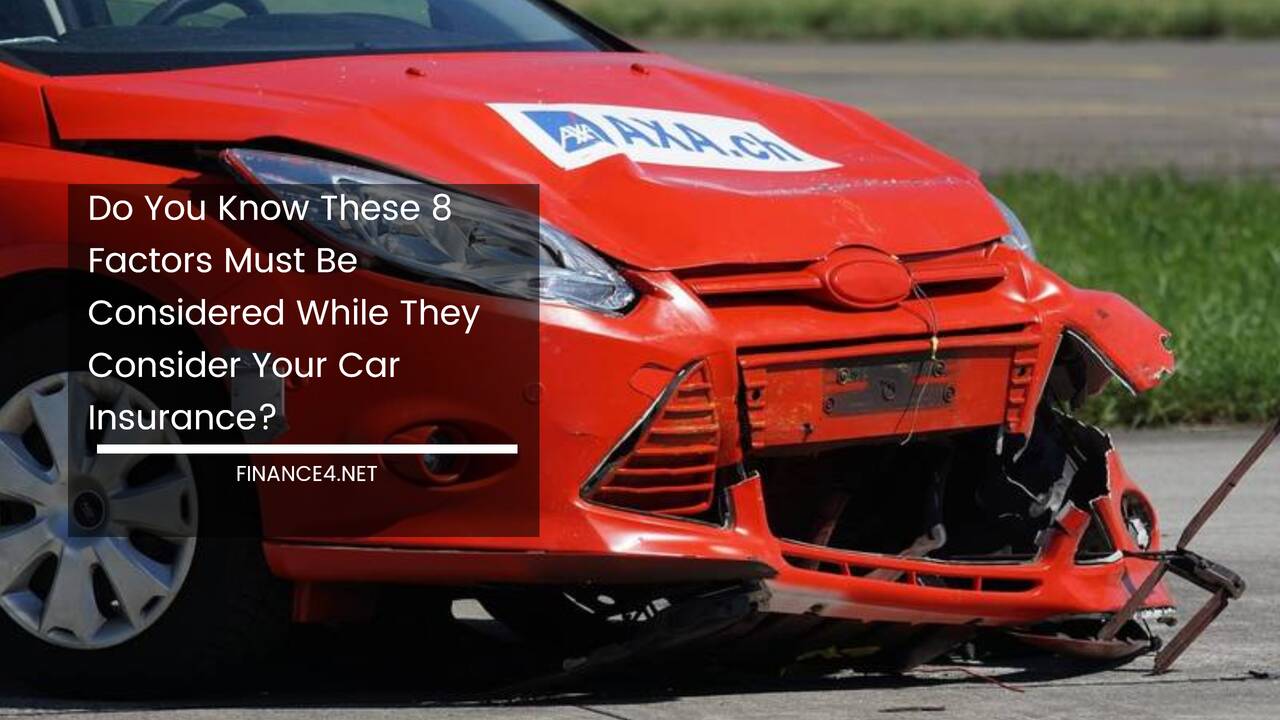Do You Know These 8 Factors That Affect Your Car Insurance Premium?

Demystifying Your Car Insurance Premium: A Guide to the 8 Key Factors
Car insurance is a crucial shield against financial hardship in the event of an accident. But navigating the world of car insurance premiums can feel like deciphering a secret code.
Why does one person pay significantly more than another for seemingly similar coverage? The answer lies in a complex web of factors that insurance companies consider when assessing your risk profile.
Understanding these factors empowers you to take control and potentially save money on your car insurance.
The Art of Risk Assessment: The Underpinning of Car Insurance Pricing
At its core, car insurance is a risk-sharing agreement. Insurance companies analyze vast amounts of data to determine the likelihood of you filing a claim and the potential cost associated with it. The higher the perceived risk, the higher your premium will be. This risk assessment hinges on several key factors, let’s delve into the eight most influential ones:
- Age: A Spectrum of Risk
Age plays a significant role in determining your premium. Statistically, drivers under 25 are more likely to be involved in accidents, leading to higher premiums.
This is due to a combination of factors like less driving experience, increased risk-taking behavior, and potentially late-night driving habits.
Conversely, drivers between 50 and 65 are generally considered safer drivers due to their experience and maturity. They often qualify for the most attractive rates, reflecting their lower risk profile.
- Gender and Marital Status: Evolving Trends
Traditionally, car insurance premiums have reflected the notion that women are safer drivers than men. While some companies may still consider gender, this trend is evolving as more women take to the roads and driving habits become a more prominent factor.
Marital status can also influence premiums to a lesser extent. Married drivers, particularly those with families, may be seen as settling down and taking fewer risks, potentially leading to lower rates compared to single drivers of a similar age and gender.
- Experience Matters: Building a Safe Driving History
The longer you’ve been driving without accidents or violations, the better. A seasoned driver with a clean record translates to a lower risk profile in the eyes of insurance companies. This translates to significant savings on your premium. Conversely, new drivers with limited experience face higher premiums due to the increased statistical likelihood of accidents.
- Location, Location, Location: A Geographical Impact
Where you live significantly impacts your car insurance cost. Drivers in areas with low traffic congestion and lower accident rates generally pay less than those in bustling cities with higher accident statistics.
Additionally, neighborhoods with a higher prevalence of vehicle theft will see increased premiums due to the greater risk of the car being stolen. It’s a geographical balancing act – the more cars on the road and the higher the crime rate, the higher the premium.
- Your Vehicle: A Reflection of Risk and Repair Costs
The type of car you drive directly affects your insurance cost. Expensive SUVs or sports cars with high repair or replacement costs will come with higher premiums compared to a basic sedan.
This is because insurance companies factor in the potential cost of repairs or total loss in the event of an accident.
Luxury vehicles with sophisticated technology or high-performance engines also tend to be more expensive to repair, leading to higher premiums.
- Occupation and Mileage: Risk on the Road and Behind the Desk
Your job can influence your premium in surprising ways. Insurance companies may consider occupations that involve extensive driving or high-risk activities, such as construction workers or delivery drivers, as factors that increase the likelihood of an accident. Similarly, the distance you commute to work can also affect your premium.
Those who drive long distances daily are seen as being on the road more often, potentially leading to a higher risk of accidents.
- Credit Rating: An Unexpected Factor
This might come as a surprise, but your credit score can play a role in determining your car insurance premium. Some insurance companies view a poor credit rating as an indicator of potential risk, suggesting a less responsible lifestyle and potentially leading to higher premiums. Conversely, maintaining a good credit score can help you secure lower car insurance rates.
- Driving Record: The Most Important Factor
This is the most significant factor influencing your car insurance premium. Drivers with a clean driving record, free of accidents and claims, will enjoy significantly lower premiums compared to those with a history of accidents, violations, or DUIs.
Traffic violations, speeding tickets, and especially DUIs are red flags for insurance companies, leading to substantial premium hikes. Maintaining a clean driving record is the single most effective way to keep your car insurance costs down.
Beyond Understanding: Strategies to Save on Car Insurance
Armed with this knowledge, you can take proactive steps to manage your car insurance costs:
- Embrace the Deductible: A deductible is the amount you pay out of pocket before your insurance kicks in. Choosing a higher deductible can significantly lower your premium. However, make sure you can comfortably afford the deductible in case of an accident. Striking a balance between affordability and financial security is key.
-
Discounts to Your Advantage: Many insurance companies offer a variety of discounts to reward responsible drivers and incentivize safety measures. Here are some to explore:
- Good Driver Discount: Maintaining a clean driving record for a set period (usually 3-5 years) can qualify you for this significant discount.
- Defensive Driving Course Completion: Taking a defensive driving course can demonstrate your commitment to safe driving habits and earn you a discount.
- Multi-Car Discount: Insuring multiple vehicles with the same company often comes with a discount.
- Student with Good Grades Discount: Being a good student with excellent grades can translate to a discount, reflecting a responsible attitude.
- Low Mileage Discount: If you drive fewer miles annually, you may qualify for a discount recognizing the reduced risk of accidents.
- Safety Feature Discounts: Cars equipped with anti-theft devices, airbags, or other safety features may qualify for a discount.
-
Loyalty Can Pay Off: Staying with the same insurance company for a long period can sometimes earn you a loyalty discount. However, it’s always wise to compare quotes periodically to ensure you’re getting the best rate.
-
Shop Around and Compare: Don’t settle for the first quote you receive. The insurance market is competitive, and rates can vary significantly between companies. Get quotes from multiple reputable insurance providers to find the best coverage at the most affordable price.
-
Bundle and Save: Consider bundling your car insurance with other policies, such as homeowners or renters insurance, with the same company. Many providers offer bundling discounts for insuring multiple policies.
By understanding the factors that influence your car insurance premium and taking proactive steps to manage your risk profile, you can navigate the world of car insurance with confidence.
Remember, a combination of a clean driving record, responsible car choices, and smart shopping habits can lead to significant savings on your car insurance, putting more money back in your pocket.



